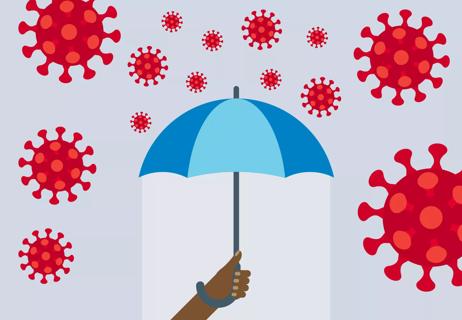It’s important to connect with a healthcare provider, get quality sleep and balance your activities with your energy levels

You had COVID-19 a few weeks or even months ago. But you’re still dealing with the symptoms of the infection, like fatigue and shortness of breath.
Advertisement
Cleveland Clinic is a non-profit academic medical center. Advertising on our site helps support our mission. We do not endorse non-Cleveland Clinic products or services. Policy
You could be part of a group of individuals who experience long-term effects of COVID-19. Whether you call it long COVID, long-haul COVID or chronic COVID, the terms all mean the same thing: You’re still not 100%.
And when you’re feeling tired or fatigued all the time, as well as breathless, it can be frustrating.
So, how do you relieve COVID-related fatigue? And how do you know if you have long COVID? Pulmonologist and critical care specialist Michael Ghobrial, MD, explains how fatigue and shortness of breath can linger in those who’ve had COVID-19.
For most people, fatigue is a fairly common symptom of COVID-19. It often goes hand in hand with other COVID-19 symptoms and may be one of the main reasons you feel the need to rest. You may identify it as a general feeling of tiredness, dullness or lack of energy.
Sometimes, it can be hard to tell if you’ve just had a tiring day or if your fatigue is caused by (or left over from) your COVID-19 infection. Sure, we all get tired from time to time. But when you’re experiencing fatigue, you’re overly tired to the point where it affects how well you can function. You may have trouble getting up in the morning and making it through the day. Your work and personal life can start to be negatively affected, too.
Advertisement
COVID-induced fatigue will often feel like:
COVID fatigue may last after other COVID-19 symptoms have subsided or even after you test negative for the virus. Generally, you should feel the fatigue subside after two to three weeks. Depending on the severity of your case, it could also last several months.
Fatigue can be one of the most common symptoms reported in those with long COVID — which the U.S. Centers for Disease Control and Prevention (CDC) defines as experiencing long-term effects from their COVID-19 infection.
So, how do you decipher between run-of-the-mill tiredness and something more? With long COVID, it’s feeling more tired than you do after you stay up too late or feeling exhausted after a grueling workout.
A recent 2023 study defined long COVID as symptoms returning or persisting for longer than 12 weeks, even after the initial illness has passed.
“It’s a feeling that people have reported that they haven’t felt before,” says Dr. Ghobrial. “It’s a different experience, a different feeling.”
And this can last beyond the 12-week period. In 2022, a study showed that almost 70% of people who initially had COVID-19 reported they were still experiencing fatigue three to 12 months after the initial infection.
While research is ongoing to understand these symptoms and how they impact individuals, we do know a few things:
In fact, one study shows that 1 in 8 people who had COVID-19 will experience symptoms up to three months after they were infected.
“In general, females, those with comorbidities or severe COVID-19 infection, as well as the African American population, have been shown to have more persistent symptoms as compared to other groups,” states Dr. Ghobrial.
It’s also possible that you can develop long COVID if you’re reinfected for a second or third time with COVID-19.
It’s important to work with your healthcare provider to pinpoint the reason for your fatigue, but there are also lifestyle changes you can make in the meantime to help manage those feelings of tiredness like:
Advertisement
Another important thing to remember when dealing with fatigue from COVID-19 is to be honest with yourself and your energy levels. There may be certain activities or social commitments that may be harder to engage in while you’re managing your fatigue. Make sure to be realistic about your own emotional and physical capacity. For example, maybe you have your partner or roommate help you with more of the heavy lifting chores. Or maybe you opt for curbside grocery delivery instead of doing the shopping on your own.
Known as dyspnea, shortness of breath is a tight feeling in your chest. It can be difficult to take deep breaths. While most people try to “catch their breath” after exercising or running, if you have long COVID, you may get winded or breathless just by walking around or going up a flight of stairs.
When you feel short of breath after having COVID-19, it may also mean that your respiratory system was damaged during your infection. If you’re concerned, speak with a healthcare provider about running tests like X-rays or CT scans to see if there are any abnormalities.
“There is a recent study that shows that people who have self-reported symptoms despite normal imaging are more likely to experience depression and anxiety,” notes Dr. Ghobrial. “It’s the role of the doctor to help educate and alleviate their concerns.”
Advertisement
There’s also a concern about shortness of breath and the stress it can put on your heart and cardiovascular system.
“Your heart will have to overwork to compensate for your shortness of breath,” explains Dr. Ghobrial. “If you’re hyperventilating, or breathing faster than normal, your expected heart rate and expected blood pressure will be higher than someone who’s just breathing normally. And this increased heart rate and blood pressure could be stressful for someone who already has a cardiovascular abnormality.”
If you’re dealing with shortness of breath or other respiratory illnesses six to eight weeks beyond your initial COVID-19 infection, you should see a specialist for your symptoms.
“Your doctor can refer you to specific exercise programs designed for pulmonary function improvement or physical therapists who are specifically trained to help patients perform breathing exercises,” says Dr. Ghobrial.
Other ways to help with your lung function include:
If you’re worried that your COVID-related fatigue could be leaning into long COVID territory, Dr. Ghobrial says that it’s key to speak to a healthcare provider about any lingering fatigue you may have.
Advertisement
“You really need to be seen, be heard and report your symptoms,” he stresses.
But he cautions that there are significant wait times for people who want to be seen by specialists for long COVID. Some clinics across the country have started multidisciplinary visits where you can be seen by a variety of specialties and receive any testing you may need.
Still, there is hope. It may take some time to see improvement, but your doctor can work with you to find a solution that brings relief.
“During follow-ups, people have said their long COVID symptoms are getting better and they’re able to perform their day-to-day activities,” reassures Dr. Ghobrial. “Their improvement is not on a day-to-day basis. It’s more on a week-to-week or month-to-month basis where they’re noticing that they’re feeling better.”
Learn more about our editorial process.
Advertisement

The short answer: It’s complicated, but the basic care precautions still prevail, like washing your hands and isolating if you’re sick

They can feel like a typical headache or a migraine headache, but the pain can last for weeks to months

Any large social gathering — from a family birthday party to an indoor music concert — has the potential to spread serious infection

Just like the flu, COVID-19 will continue to evolve every year

The duration varies, but symptoms can linger for a few days up to a couple weeks or more

Vaccination is best for prevention, but if you get sick with COVID-19, treatments are available

The virus lives best in humans, but it can last on hard surfaces, like doorknobs and railings

Like the flu and RSV, COVID-19 cases are rising seasonally

Type 2 diabetes isn’t inevitable with these dietary changes

Applying a hot or cold compress can help with pain